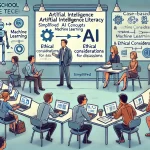
The Future of Bioinformatics Tools and Databases: Embracing Cloud Computing and Big Data Innovations
November 26, 2023I. Introduction: Unveiling the Essence of Bioinformatics
In the intricate tapestry of life sciences, Bioinformatics emerges as the guiding thread, weaving together the realms of biology, computer science, and data analytics. Let us embark on a journey to decipher the profound significance of Bioinformatics.
A. Definition of Bioinformatics
- The Confluence of Information and Biology: Bioinformatics, at its core, is the harmonious amalgamation of biological information and computational methodologies. It employs advanced computational techniques to interpret, analyze, and decipher the vast tapestry of biological data, unraveling the secrets encoded within DNA, proteins, and the intricate pathways of life.
B. Growing Importance of Bioinformatics in Life Sciences
- A Catalyst for Scientific Advancement: In the contemporary landscape of life sciences, Bioinformatics emerges as a catalyst propelling research and discovery forward. From deciphering the human genome to elucidating the complexities of ecosystems, Bioinformatics is the linchpin that accelerates our understanding of the fundamental building blocks of life.
C. Challenges of Handling Massive Biological Datasets
- Navigating the Sea of Data: As the scope and scale of biological data burgeon, so do the challenges. Bioinformatics grapples with the colossal task of managing and making sense of massive datasets generated by genomics, proteomics, and other -omics disciplines. The sheer volume and complexity of biological information necessitate advanced computational tools and strategies.
Embark with us on this expedition into the realm of Bioinformatics, where the fusion of biological insights and computational prowess heralds a new era in understanding life’s intricate dance. The journey unfolds, promising revelations and innovations at the intersection of biology and informatics.
II. Cloud Computing in Bioinformatics: Navigating the Skies of Data
As we delve into the realm of Bioinformatics, the clouds above us take on a new significance — the ethereal expanse of cloud computing. Let’s unravel the tapestry of this technological innovation and explore how it transforms the landscape of Bioinformatics.
A. Overview of Cloud Computing
- Defining the Digital Firmament: Cloud computing, akin to the celestial clouds, provides a virtual space for storing, processing, and accessing data over the internet. This paradigm shift in computing revolutionizes how Bioinformatics tackles the ever-expanding frontiers of biological data.
B. Advantages for Bioinformatics
- Accessibility: Cloud computing extends its reach, breaking down barriers to access. Researchers worldwide can seamlessly connect to shared resources, fostering collaboration and democratizing the pursuit of knowledge.
- Scalability: Like the expansiveness of the sky, the cloud scales dynamically. Bioinformatics applications, often grappling with massive datasets, find solace in the scalable nature of cloud resources, ensuring computational power aligns with the complexities of analyses.
- Cost-effectiveness: In the cloud, efficiency meets economy. Researchers can optimize resource usage, paying only for what they consume. This cost-effectiveness liberates financial constraints, allowing Bioinformatics endeavors to soar.
C. Cloud-Based Bioinformatics Tools and Databases
- Examples of Cloud Platforms: From giants like Amazon Web Services (AWS) to nimble platforms like Google Cloud and Microsoft Azure, a plethora of cloud providers offer specialized environments catering to Bioinformatics needs.
- Key Features and Functionalities: Cloud-based Bioinformatics tools and databases boast features tailored for efficiency — parallel processing, on-demand resource allocation, and seamless integration with diverse datasets.
Embark on this journey through the clouds, where Bioinformatics ascends to new heights. The cloud, with its accessibility, scalability, and cost-effectiveness, becomes the canvas upon which groundbreaking discoveries in the life sciences unfold. The digital firmament awaits exploration, promising a horizon of possibilities for Bioinformatics in the cloud.
III. Big Data Revolution in Bioinformatics: Decoding the Genome of Possibilities
As we navigate the vast landscape of Bioinformatics, the winds of change carry us into the realm of Big Data. Buckle up for an exhilarating journey as we explore the pivotal role of massive datasets in deciphering the intricacies of life sciences.
A. Introduction to Big Data in Life Sciences
- Beyond the Genome: Big Data in life sciences transcends the traditional confines, encompassing genomics, transcriptomics, proteomics, and metabolomics. It heralds an era where the volume, velocity, and variety of biological data redefine the boundaries of exploration.
B. Handling Massive Datasets
- Genomics: The blueprint of life, genomics unravels the mysteries encoded in DNA. Big Data technologies empower researchers to grapple with the colossal genomic datasets, uncovering the secrets of genetic variation and heredity.
- Transcriptomics: Navigating the transcriptomic landscape, where the symphony of gene expression plays out. Big Data tools orchestrate the analysis of vast transcriptomic datasets, unveiling the dynamic narratives scripted by RNA.
- Proteomics: In the realm of proteins, Big Data unveils the complexities of structure, function, and interactions. The colossal datasets in proteomics become legible through advanced analytics, painting a detailed portrait of the protein landscape.
- Metabolomics: Delving into the molecular metabolites that orchestrate cellular processes. Big Data analytics in metabolomics dissects intricate metabolic pathways, providing insights into physiological states and disease mechanisms.
C. Applications of Big Data in Bioinformatics
- Disease Diagnosis: Big Data becomes a diagnostic ally, sifting through vast datasets to identify patterns, biomarkers, and signatures that herald the onset of diseases.
- Treatment Optimization: Personalizing treatments with precision, leveraging Big Data to tailor therapeutic strategies based on individual genetic makeup and molecular profiles.
- Drug Discovery: The labyrinth of drug discovery is navigated with finesse, as Big Data algorithms sift through immense datasets to pinpoint potential drug candidates and predict their efficacy.
- Personalized Medicine: In the era of precision, Big Data fuels the engine of personalized medicine, steering healthcare toward individualized treatment plans aligned with a person’s unique biological makeup.
Embark on this odyssey into the Big Data cosmos, where the vastness of information converges with the intricacies of life sciences. The revolution is underway, and Bioinformatics stands at the helm, decoding the genome of possibilities with the power of Big Data.
V. Convergence of Cloud Computing and Big Data: Crafting a Symphony of Possibilities
As we ascend higher into the realms of Bioinformatics, the convergence of Cloud Computing and Big Data emerges as a celestial orchestra. Witness the harmonious integration of technologies that propel research, analysis, and collaboration to unprecedented heights.
A. Integrated Cloud-Based Platforms
- Unifying Storage and Analysis: The cloud becomes the nexus, seamlessly intertwining vast storage capabilities with robust analytical tools. Researchers experience the symbiosis of data storage and analysis, eliminating silos and unlocking a unified ecosystem.
- Streamlining Research Workflows: Cloud-based platforms orchestrate a symphony of efficiency, optimizing research workflows. From data acquisition to analysis, every note resonates with precision, accelerating the pace of scientific discovery.
B. Artificial Intelligence (AI) and Machine Learning (ML) Integration
- Automation of Data Analysis: The marriage of AI and Big Data heralds an era of automated analysis. Algorithms, guided by machine learning, navigate the intricate landscapes of biological data, automating tasks and unraveling patterns that elude the human eye.
- Predictive Modeling: AI’s predictive prowess takes center stage, forecasting outcomes and trends based on the vast datasets at its disposal. Machine learning models, fueled by Big Data, become virtuoso performers, predicting biological phenomena with unparalleled accuracy.
C. Federated Data Sharing
- Secure Collaboration Across Institutions: The curtain rises on a new era of collaboration as federated data sharing takes the spotlight. Cloud-based platforms facilitate secure data exchange among institutions, transcending geographical boundaries and fostering a global network of collaborative research.
- Fostering Open Science: In this symphony of knowledge, the ethos of open science takes center stage. Cloud-enabled federated data sharing promotes transparency, enabling researchers worldwide to contribute, access, and build upon a shared pool of knowledge.
Join us as we witness the convergence of Cloud Computing and Big Data, a symphony that transcends the limitations of traditional research. In this harmonious blend, the power of the cloud and the depth of Big Data converge, composing a melody of possibilities that resonate throughout the vast landscape of Bioinformatics.
V. Future Trends in Bioinformatics Tools and Databases: Navigating the Next Frontier
As the Bioinformatics odyssey unfolds, the future beckons with promises of innovation and transformation. Embark on a journey into the uncharted territories of tomorrow, where tools and databases evolve, guided by the winds of technological advancement.
A. Continued Evolution of Cloud-Based Platforms
The cloud, a celestial realm for data in Bioinformatics, is poised for perpetual evolution. Witness the unfolding chapters of cloud-based platforms, where accessibility, scalability, and collaboration intertwine. As the symphony of data continues, the cloud’s role expands, bringing forth novel features, enhanced security, and a seamless integration of computational resources.
B. Growing Role of AI and ML Algorithms
In the Bioinformatics landscape, the ascendance of AI and ML heralds a new era of intelligence. As algorithms become virtuosos, their role extends beyond automation. Anticipate the emergence of algorithms as collaborators, generating hypotheses, and offering novel insights. The future unfolds with algorithms that learn, adapt, and illuminate the intricacies of biological data with unparalleled sophistication.
C. Advancements in Federated Data Sharing
The future of data sharing is a global symphony, orchestrated through federated collaboration. Experience the rise of enhanced protocols ensuring secure and privacy-preserving data exchange. Institutions become interconnected nodes in a network, sharing insights while preserving the sanctity of individual datasets. The stage is set for a paradigm shift towards collaborative research on a global scale.
D. Implications for Research and Healthcare
The future trends ripple across the realms of research and healthcare, leaving an indelible mark. Witness the acceleration of scientific discovery as researchers traverse expansive datasets with newfound ease. In healthcare, personalized treatments become the crescendo, orchestrated by the harmonious interplay of Bioinformatics tools. As the curtain falls on the present, the future beckons with possibilities, where Bioinformatics transcends boundaries, illuminating the path towards a deeper understanding of life’s intricate symphony.
VI. Conclusion: Charting the Course Ahead in Bioinformatics
As the curtain descends on this exploration into the vast realms of Bioinformatics, let us pause to reflect on the transformative odyssey we’ve undertaken. The journey through the intricate tapestry of data, algorithms, and knowledge has illuminated the pivotal role of Bioinformatics in reshaping the landscape of life sciences.
A. Recap of the Transformative Potential
In retracing our steps, we’ve witnessed how Bioinformatics breathes life into data, unraveling the mysteries encoded in the genome, proteome, and beyond. The journey began with an exploration of the fundamental components—the databases, tools, and the synergy with cloud computing. With each chapter, we delved into the applications—ranging from drug discovery to precision medicine—where Bioinformatics stands as a catalyst for innovation.
B. Call to Embrace Innovations in Bioinformatics
The call echoes for researchers, healthcare professionals, and innovators to embrace the ever-evolving innovations in Bioinformatics. As technologies converge and computational prowess amplifies, the tools at our disposal become more sophisticated. The clarion call is to harness these innovations to unlock new frontiers in research, diagnostics, and personalized care.
C. The Bright Future of Bioinformatics in Shaping Healthcare
Peering into the future, the horizon is aglow with the promises of Bioinformatics shaping the trajectory of healthcare. From cloud-integrated platforms to the harmonious collaboration with AI, the future holds the keys to unlocking unprecedented insights. As Bioinformatics continues to evolve, it stands as a beacon illuminating the path towards a healthier, more informed, and personalized future.
As we bid adieu to this exploration, let us carry forth the torch of Bioinformatics, lighting the way towards a future where the language of data unfolds the mysteries of life.















